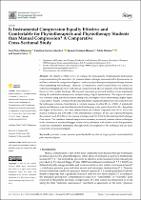Por favor, use este identificador para citar o enlazar este ítem:
https://repositorio.usj.es/handle/123456789/770
Registro completo de metadatos
| Campo DC | Valor | Lengua/Idioma |
|---|---|---|
| dc.contributor.author | Pérez-Palomares, Sara | - |
| dc.contributor.author | Jiménez Sánchez, Carolina | - |
| dc.contributor.author | Serrano-Herrero, Ignacio | - |
| dc.contributor.author | Herrero Gállego, Pablo | - |
| dc.contributor.author | Calvo Carrión, Sandra | - |
| dc.date.accessioned | 2022-04-21T11:42:37Z | - |
| dc.date.available | 2022-04-21T11:42:37Z | - |
| dc.date.issued | 2021-11-18 | - |
| dc.identifier.citation | Pérez-Palomares, S.; Jiménez-Sánchez, C.; Serrano-Herrero, I.; Herrero, P.; Calvo, S. Is Instrumental Compression Equally Effective and Comfortable for Physiotherapists and Physiotherapy Students than Manual Compression? A Comparative Cross-Sectional Study. Int. J. Environ. Res. Public Health 2021, 18, 12121. https://doi.org/ 10.3390/ijerph182212121 | es_ES |
| dc.identifier.issn | 1661-7827 | es_ES |
| dc.identifier.uri | https://repositorio.usj.es/handle/123456789/770 | - |
| dc.description.abstract | The objective of this work is to compare the homogeneity of instrumental and manual compression during the simulation of a pressure release technique, measured with a dynamometer, as well as to evaluate the comparative degree of comfort by physiotherapists and physiotherapy students when performing this technique. Methods: A comparative cross-sectional study was carried out with physiotherapists (lecturers with clinical experience) and 4th year students of the Physiotherapy Degree at Universidad San Jorge. The amount of pressure performed and how it was maintained during 80 s with both techniques was analysed using a digital dynamometer. The degree of comfort was evaluated using a modified numeric rating scale, with higher values representing a higher degree of discomfort. Results: A total of 30 subjects participated. Significant differences were found between the techniques in terms of maintaining a constant pressure level for 80 s (p = 0.043). A statistically significant difference was found between both techniques in the period from 45 to 80 s. Regarding the degree of discomfort, the value obtained from the students’ responses was 4.67 (1.35) for the manual technique and 1.93 (0.88) for the instrumental technique. In the case of physiotherapists, the comfort was 4.87 (2.13) for the manual technique and 3.33 (1.54) for the instrumental technique. Conclusion: The sustained manual compression necessary in manual pressure release techniques in the treatment of myofascial trigger points can be performed with assistive tools that guarantee a uniform compression maintained throughout the development of the technique and are more comfortable for physiotherapists. | es_ES |
| dc.format.extent | 11 p. | es_ES |
| dc.format.mimetype | application/pdf | es_ES |
| dc.language.iso | spa | es_ES |
| dc.publisher | MDPI | es_ES |
| dc.rights | Atribución 4.0 Internacional | * |
| dc.rights.uri | http://creativecommons.org/licenses/by/4.0/ | * |
| dc.subject | Pressure release | es_ES |
| dc.subject | Pressure pain threshold | es_ES |
| dc.subject | Myofascial trigger points | es_ES |
| dc.subject | Musculoskeletal pain | es_ES |
| dc.subject | Myofascial pain | es_ES |
| dc.title | Is Instrumental Compression Equally Effective and Comfortable for Physiotherapists and Physiotherapy Students than Manual Compression? A Comparative Cross-Sectional Study | es_ES |
| dc.type | info:eu-repo/semantics/article | es_ES |
| dc.identifier.doi | 10.3390/ijerph182212121 | es_ES |
| dc.rights.accessrights | info:eu-repo/semantics/openAccess | es_ES |
| Aparece en las colecciones: | Artículos de revistas | |
Ficheros en este ítem:
| Fichero | Descripción | Tamaño | Formato | |
|---|---|---|---|---|
| Is Instrumental Compression Equally Effective and Comfortable for Physiotherapists and Physiotherapy Students than Manual Compression.pdf | 778,38 kB | Adobe PDF |  Visualizar/Abrir |
Este ítem está sujeto a una licencia Creative Commons Licencia Creative Commons

